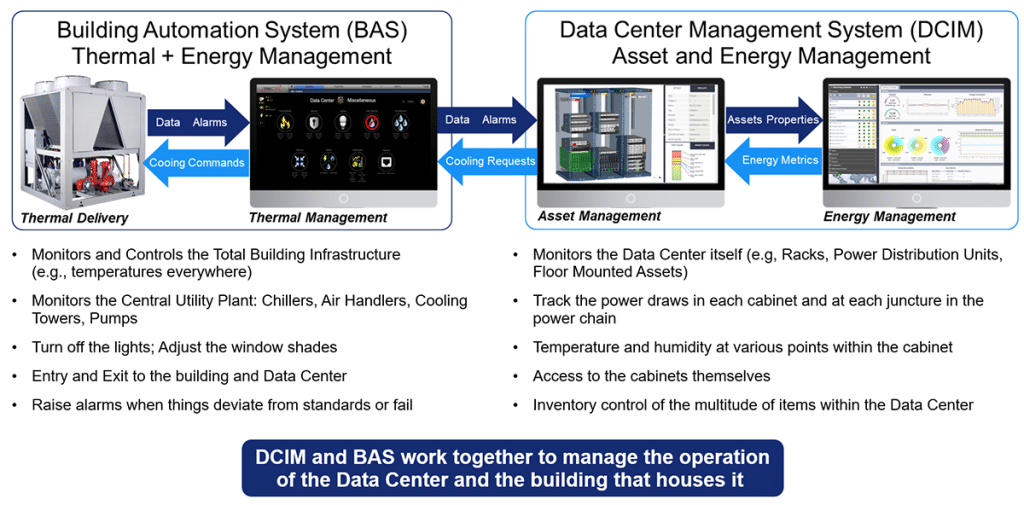Integrating Building Automation System and Data Center Infrastructure Management System for Sustainable Data Centers
Published on April 12, 2023,
by
As sustainability becomes a top priority, BAS DCIM integration is transforming how data centers operate. By uniting Building Automation Systems (BAS) with Data Center Infrastructure Management (DCIM) platforms, organizations gain real-time visibility and control over both facility and IT systems. This synergy enhances energy efficiency, reduces waste, and supports long-term environmental goals.
What Is BAS and DCIM Integration?
- Building Automation Systems (BAS) control and monitor a facility’s core systems—like HVAC, lighting, and security—to optimize energy use and comfort.
- DCIM platforms provide visibility and control over the IT and physical infrastructure of a data center, including power, cooling, and server utilization.
When these two systems work together, they create a unified, intelligent environment that enhances efficiency and sustainability.

Key Benefits of Integration
1. Enhanced Energy Efficiency
By combining BAS and DCIM, operators can monitor and manage both IT and facility systems in real time. This leads to smarter energy use, reduced waste, and lower operational costs.
2. Real-Time Monitoring and Reporting
Integrated systems provide a comprehensive view of environmental conditions—like temperature, humidity, and power usage—allowing for quick responses to potential issues and better performance tracking.
3. Predictive Maintenance
Analyzing data from both systems helps identify patterns that signal equipment wear or failure. This enables proactive maintenance, reducing downtime and extending equipment life.
4. Improved Sustainability
Optimizing energy use and reducing waste directly supports sustainability goals. Integrated systems help data centers shrink their carbon footprint and contribute to a greener future.
A Real-World Example
Imagine a data center that integrates BAS and DCIM, then implements energy-saving strategies like free cooling, HVAC optimization, and server consolidation. Over time, the center’s Data Center Infrastructure Efficiency (DCiE) improves from 0.6 to 0.8—a significant leap in energy performance.
Conclusion
Integrating BAS and DCIM isn’t just a technical upgrade—it’s a strategic move toward smarter, more sustainable data center operations. As the demand for digital services grows, so does the need for efficient, environmentally responsible infrastructure. With the right tools in place, data centers can meet both performance and sustainability goals.
energy efficiency and reducing waste, data centers can operate sustainably and contribute to a cleaner, greener future.
To illustrate the benefits of integrating a BAS with a DCIM, let's consider a hypothetical example. Suppose a data center operator integrates a BAS with a DCIM and implements several energy-efficient measures, such as using free cooling when possible, optimizing HVAC settings, and consolidating servers. After several months of monitoring and analysis, the operator discovers that the data center's DCiE has improved from 0.6 to 0.8, indicating a significant increase in energy efficiency. Additionally, the operator identifies areas for further improvements, such as upgrading equipment and implementing more advanced energy management techniques. By continually monitoring and optimizing the data center's energy usage, the operator can continue to improve efficiency, reduce costs, and support sustainability goals.
Conclusion
integrating a Building Automation System (BAS) with a Data Center Infrastructure Management System (DCIM) can provide significant benefits for data center operators, including improved energy efficiency, real-time monitoring and reporting, predictive maintenance, and sustainability. By leveraging the power of these innovative technologies, data centers can operate more efficiently, reduce their carbon footprint, and contribute to a cleaner, more sustainable future.
Additional Resources
Data Center Sustainability Compliance Reporting | Sustainable Data Center
Standard 90.4: Energy Standard For Data Centers, February 2023 ASHRAE Journal
Introduction to Integrated Data Center Management (IDCM) – YouTube
Integrated Data Center Management | Nlyte
Integrated Data Center Management | Automated Logic

